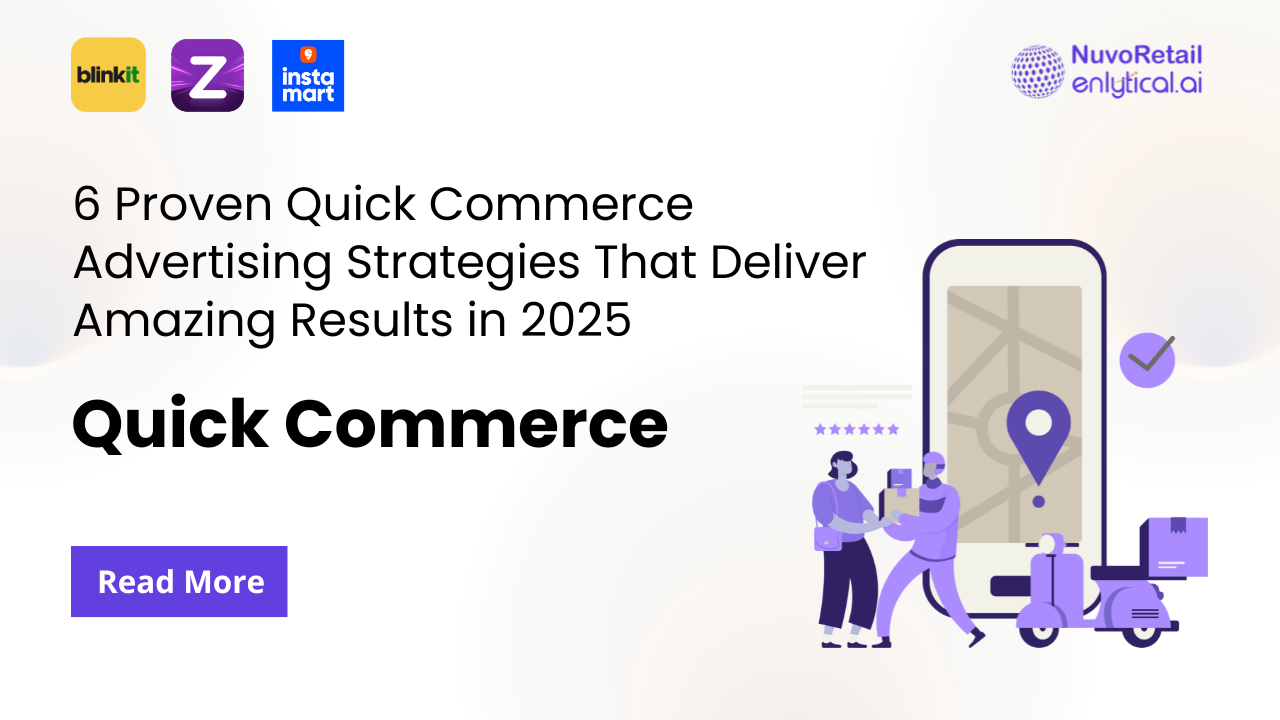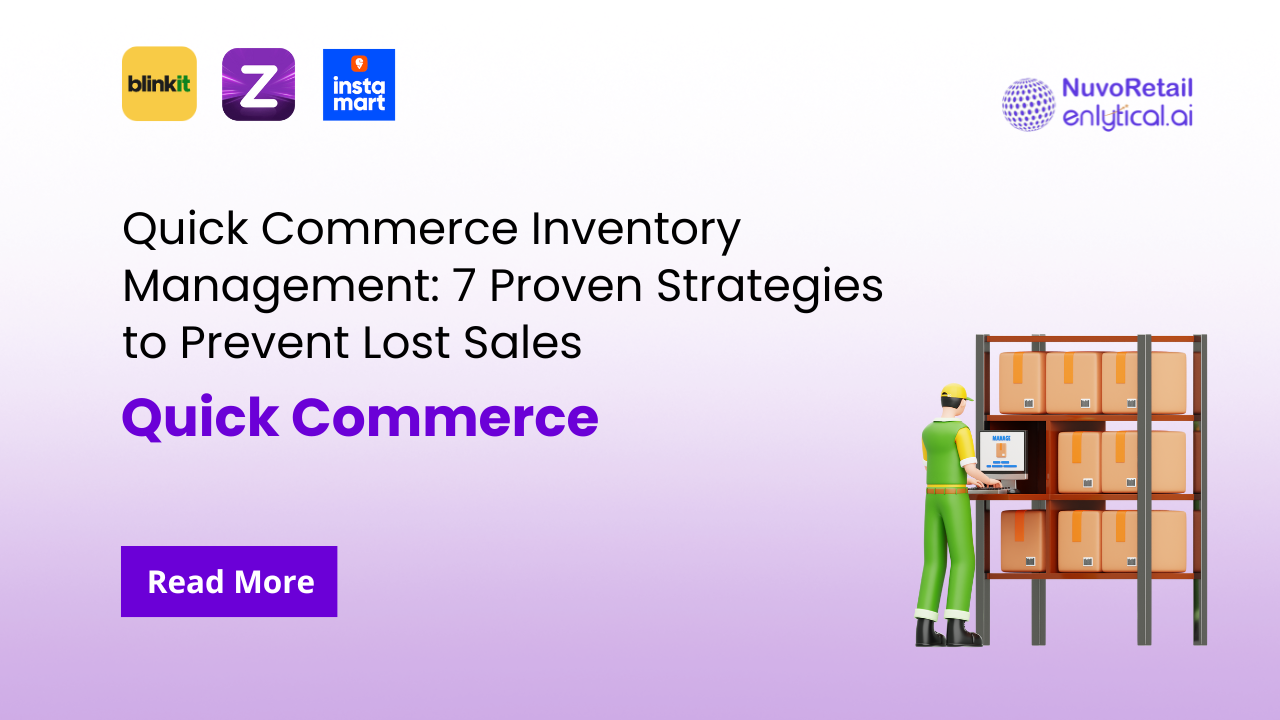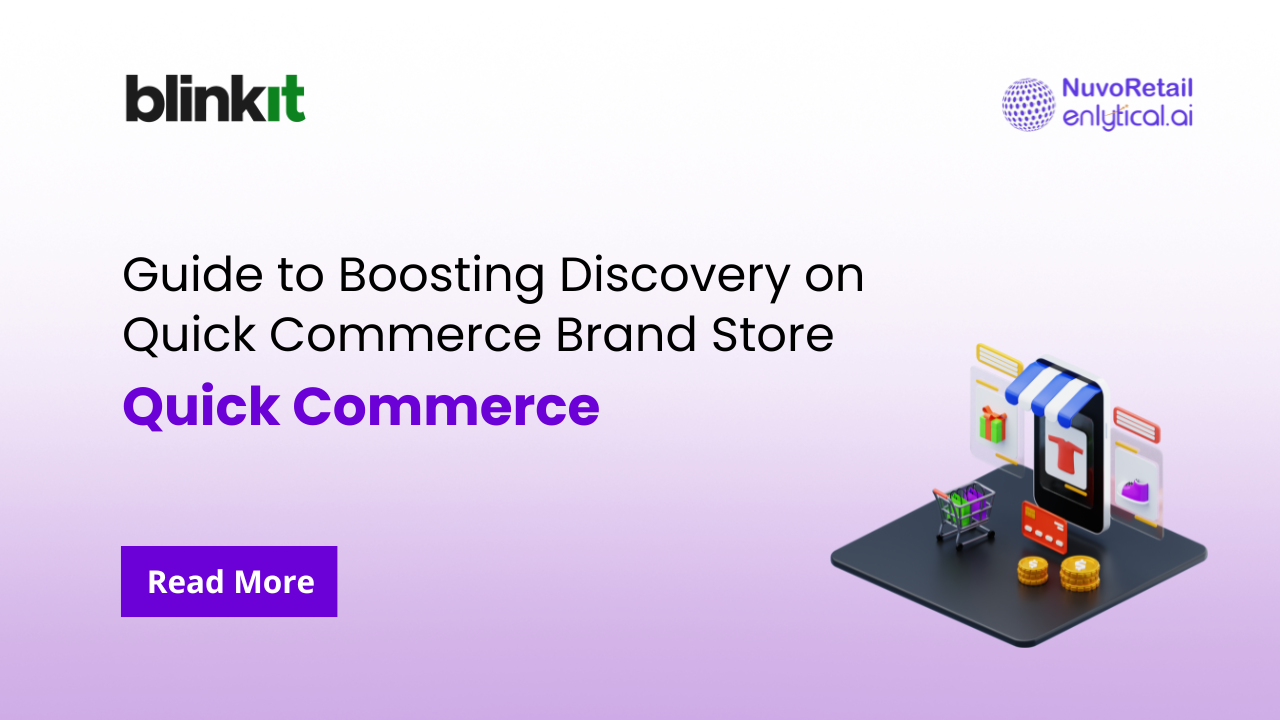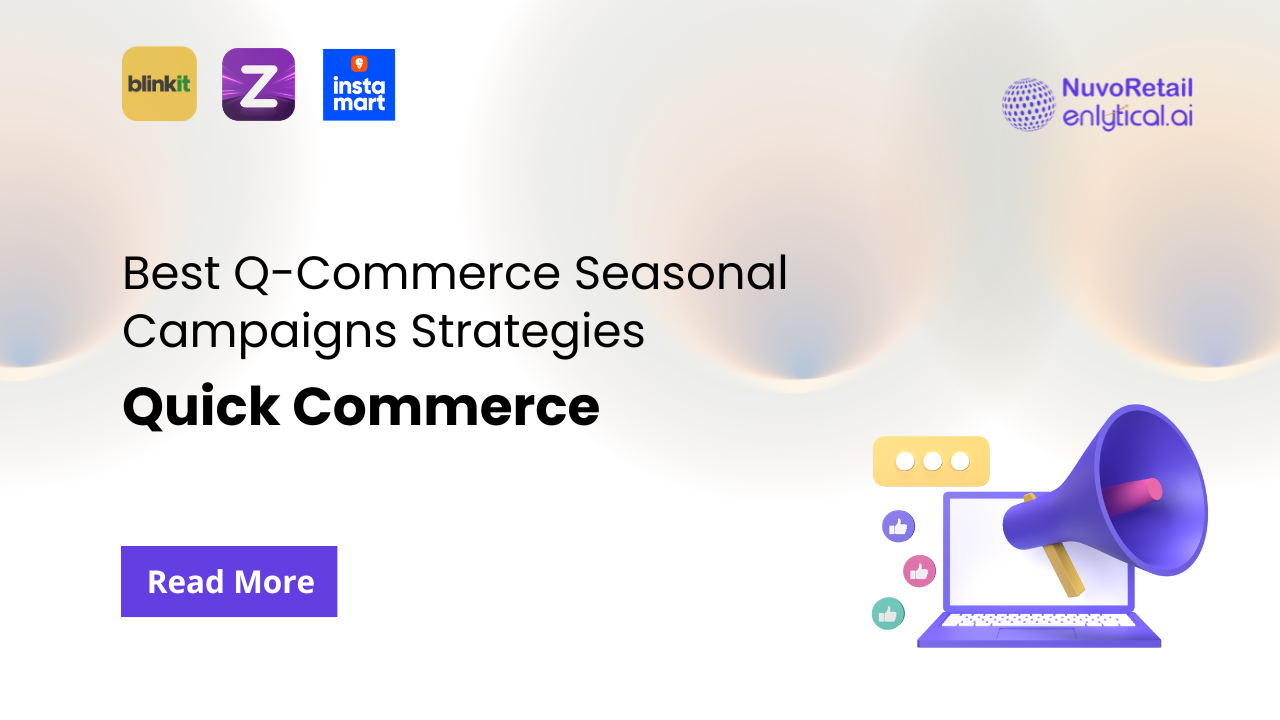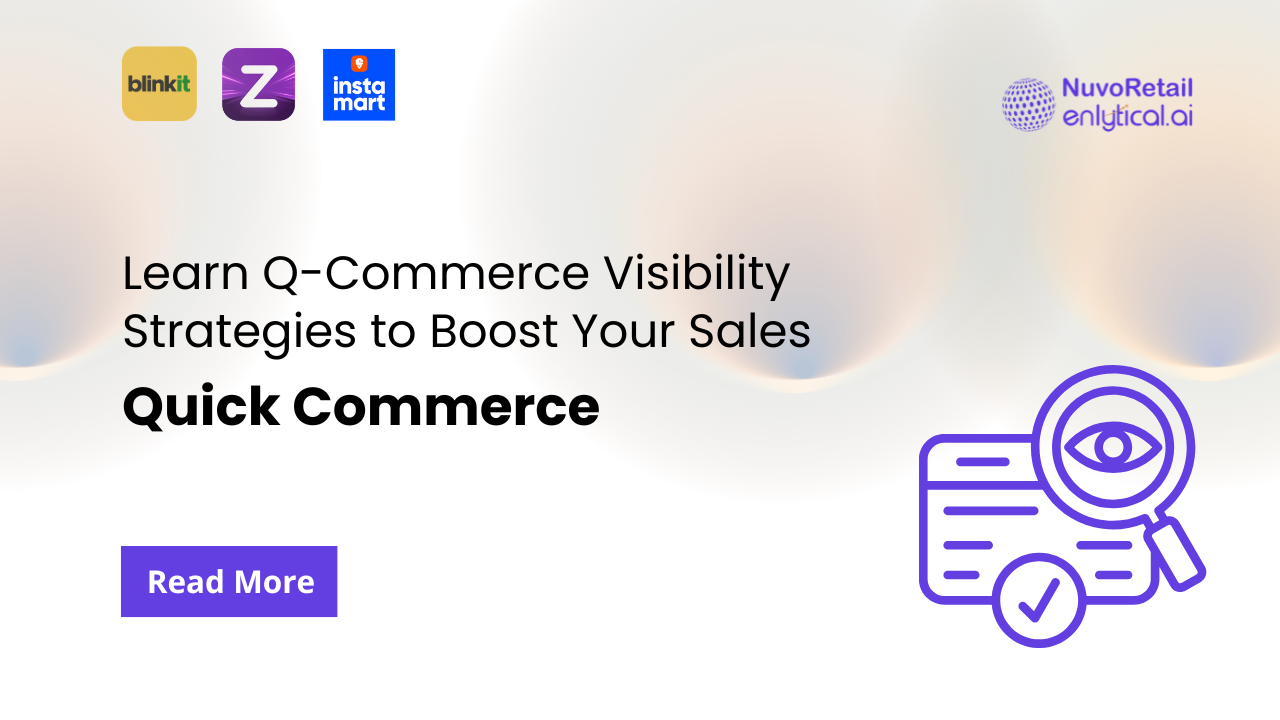Quick commerce has revolutionized how consumers shop, creating unprecedented opportunities for brands to reach customers through instant delivery platforms. As the rapid delivery market explodes with players like Blinkit, Swiggy Instamart, and Zepto leading the charge, understanding the advertising ecosystem becomes crucial for business success.
This comprehensive guide reveals the most effective quick commerce advertising strategies and metrics that drive real results in the competitive world of q commerce, helping you maximize your marketing investments across all major quick commerce platforms.
At NuvoRetail, we specialize in quick commerce marketing that help brands win on platforms like Blinkit, Swiggy Instamart, and Zepto.
Table of Contents
- Understanding Quick Commerce Advertising Fundamentals
- Key Quick Commerce Platforms and Their Ad Ecosystems
- Essential Performance Metrics for Quick Commerce Success
- 6 Proven Advertising Strategies That Work
- Assortment Planning and Digital Shelf Optimization
- Performance-Based Advertising Tactics
- Measuring and Optimizing Ad Performance
- Future Trends in Quick Commerce Marketing
Understanding Quick Commerce Advertising Fundamentals
Quick commerce meaning goes beyond traditional e-commerce – it’s about delivering products to customers within 10-30 minutes. This ultra-fast delivery model has created unique advertising opportunities that didn’t exist in conventional retail.
The quick commerce model operates on hyper-local inventory management, making advertising highly location-specific and time-sensitive. Unlike traditional e-commerce where customers might browse for hours, q commerce users make quick decisions, creating a compressed sales funnel that demands immediate impact advertising.
Key characteristics of quick commerce advertising include:
- Hyper-local targeting based on delivery zones
- Time-sensitive promotions aligned with peak demand hours
- Category-focused messaging for high-frequency purchase items
- Mobile-first creative formats optimized for app experiences
Key Quick Commerce Platforms and Their Ad Ecosystems
Blinkit App Advertising
Blinkit has emerged as a leader in the quick commerce space, offering sophisticated advertising solutions for brands. The Blinkit app provides multiple touchpoints for advertisers:
- Search ads appearing when users search for specific products
- Category banner placements at the top of product categories
- Product listing ads that boost visibility in search results
- Push notification campaigns for time-sensitive offers
Swiggy Instamart Marketing Opportunities
Swiggy Instamart leverages Swiggy’s massive user base, offering unique cross-platform advertising benefits. Brands can reach users across food delivery and grocery segments through integrated campaigns.
The Instamart app provides premium advertising real estate through sponsored product placements and category takeovers that drive immediate conversions.
Zepto’s Advertising Platform
Zepto’s rapid growth has made it an attractive platform for advertisers focusing on urban millennials and Gen Z consumers. Zepto online advertising focuses heavily on brand discovery and impulse purchases.
The platform offers performance-based advertising options that align advertiser costs with actual sales results, making it particularly appealing for emerging brands.
Essential Performance Metrics for Quick Commerce Success
Measuring success in quick commerce advertising requires understanding unique metrics that don’t apply to traditional e-commerce. These comprehensive metrics provide the foundation for optimizing quick commerce marketing campaigns across all platforms.
Primary Performance Metrics
Traffic and Visibility Metrics
- Impressions: Total ad views across all placements
- Clicks: User interactions with ads
- CPM (Cost Per Mille): Cost per 1,000 impressions
- eCPM (Effective Cost Per Mille): Revenue generated per 1,000 impressions
Conversion Funnel Metrics
- ATC (Add-to-Cart): Products added to shopping cart from ads
- ATC% (Add-to-Cart Rate): Percentage of clicks that result in cart additions
- Total Units: Quantity of products sold through advertising campaigns
Financial Performance Metrics
- Ad Spend: Total advertising investment across platforms
- Total GMV (Gross Merchandise Value): Total value of merchandise sold through a platform
- Ad ROI (Return on Investment): Ad revenue generated per rupee spent on advertising
- Total ROI: Overall return including organic lift effects
- AUV (Average Unit Value): Average revenue per transaction
Customer Acquisition Metrics
- CAC (Customer Acquisition Cost): Cost to acquire new customers through advertising
- NTB (New-to-Brand): First-time customers acquired through campaigns
- Cost Per NTB: Investment required to acquire each new brand customer
Operational Performance Metrics
- OSA (On-Shelf Availability): Percentage of advertised products in stock across various locations.
- Promo: Promotional campaign effectiveness and discount optimization
Attribution and Contribution Metrics
- Ad Contributions: Direct sales attributed to advertising campaigns
- Organic Total Sales (Ad + Org): Combined advertising and organic sales impact
- Ad %Age: Percentage of total sales driven by advertising
- Organic %Age: Percentage of sales growth from organic/non-paid channels
According to recent industry data from Redseer Strategy Consultants, quick commerce has grown rapidly, rising from less than 5% market share in 2019 to 40–45% of the total retail market in 2024, fundamentally reshaping how brands calculate advertising ROI.
For many brands, tracking and interpreting these quick commerce metrics can be complex. NuvoRetail simplifies this process with advanced analytics, helping businesses measure KPIs like ATC%, Ad ROI, and Cost per NTB with accuracy.
6 Proven Quick Commerce Advertising Strategies That Work
1. Hyper-Local Inventory-Based Targeting
Quick commerce companies excel when they align advertising with real-time inventory data. This strategy involves:
- Promoting products with high local availability
- Adjusting ad spend based on inventory levels
- Creating location-specific offers for overstocked items
- Optimizing OSA rates to ensure advertised products remain available
2. Peak Hour Optimization
Rapid delivery services see distinct usage patterns. Optimize campaigns for:
- Morning rush hours (8-10 AM) for breakfast and essentials
- Evening peak times (6-9 PM) for dinner ingredients
- Late night periods (9 PM-12 AM) for snacks and beverages
- Monitor Impressions and Clicks during these peak windows
3. Category-Specific Seasonal Campaigns
Develop targeted campaigns around high-frequency categories:
- Fresh produce promotions during weekend meal prep periods
- Beverages and snacks during sports events and entertainment
- Health and wellness products during fitness-focused months
- Track ATC% and AUV variations across different categories
4. Performance-Based Advertising Integration
Performance based advertising models work exceptionally well in quick commerce due to immediate conversion tracking:
- Cost-per-acquisition (CPA) campaigns tied to actual purchases
- Revenue-sharing models with platform partners
- Dynamic bidding based on conversion likelihood
- Optimize CAC and Cost Per NTB for sustainable growth
For deeper insights into performance marketing strategies, we provide end-to-end performance marketing services. Explore our offerings to see how we can help maximize your ROI.
5. Digital Shelf Optimization
The digital shelf in quick commerce requires constant optimization:
- A/B testing product images and descriptions
- Optimizing product rankings within categories
- Managing pricing competitiveness across platforms
- Monitor eCPM performance across different shelf positions
6. Micro-Moment Marketing
Capture customers during critical decision moments:
- Weather-triggered promotions (ice cream during hot days)
- Event-based marketing (party supplies before weekends)
- Complementary product suggestions (chips with beverages)
- Track Total Units and Total GMV from impulse-driven campaigns
Assortment Planning and Digital Shelf Optimization
Assortment planning in quick commerce differs significantly from traditional retail due to space constraints and rapid turnover requirements.
Successful assortment strategy involves:
Data-Driven Product Selection
- Analyzing local purchasing patterns using Total Units and AUV data
- Seasonal demand forecasting based on historical GMV trends
- Competitor assortment gap analysis
Digital Shelf Management
- Optimizing product visibility algorithms
- Managing inventory display priorities
- Coordinating promotional calendars with Promo effectiveness metrics
Category Performance Tracking
- Monitoring category contribution margins
- Tracking inventory velocity by location using OSA metrics
- Adjusting assortment based on Ad Contributions performance
Performance-Based Quick Commerce Advertising Tactics
Performance based advertising has become the cornerstone of successful quick commerce marketing due to its measurable ROI and direct correlation to sales.
Key Performance Advertising Models
Return on Ad Spend (ROAS) Optimization
- Target 4:1 to 8:1 Ad ROI for sustainable growth
- Adjust bids based on lifetime customer value
- Focus on categories with repeat purchase potential
- Balance Ad %Age with Organic %Age for optimal growth
Dynamic Pricing Integration
- Real-time bid adjustments based on inventory levels
- Competitor pricing integration
- Demand surge pricing coordination
- Optimize CPM and eCPM based on market conditions
Measuring and Optimizing Ad Performance
Ad performance measurement in quick commerce fundamentally differs from traditional advertising due to the compressed decision-making timeframe and hyper-localized nature of the business model. The rapid delivery promise creates a unique advertising ecosystem where consumer behavior shifts from consideration-heavy purchases to impulse-driven decisions within minutes.
This accelerated purchase journey demands a sophisticated measurement philosophy that balances immediate transactional outcomes with long-term brand building objectives. Success in quick commerce advertising requires understanding the interplay between temporal factors, geographical constraints, and inventory availability—all of which influence campaign effectiveness in real-time.
The optimization process becomes a continuous feedback loop where advertising decisions must align with operational realities like stock levels, delivery capacity, and local demand patterns. This creates a dynamic environment where traditional campaign optimization cycles must compress from weeks to hours, requiring automated decision-making frameworks that can respond to market changes instantaneously.
Future Trends in Quick Commerce Marketing
The quick ecommerce landscape continues evolving rapidly, with several trends shaping advertising strategies:
Emerging Technologies
- AI-powered inventory prediction for advertising optimization
- Augmented reality product visualization in apps
- Voice commerce integration for hands-free ordering
Market Expansion
- Tier-2 and Tier-3 city quick commerce adoption
- B2B quick commerce for business supply needs
- Specialized category platforms (pharmaceuticals, electronics)
- NTB acquisition strategies for new geographic markets
Platform Evolution
Quick commerce platforms are expanding beyond groceries into:
- Fashion and lifestyle products
- Electronics and gadgets
- Health and beauty items
- Home improvement supplies
Conclusion
Quick commerce advertising represents one of the most dynamic and rapidly growing digital marketing opportunities today. Success requires understanding the unique characteristics of rapid delivery services and adapting traditional advertising strategies to the compressed sales funnel of q commerce.
The six proven strategies outlined – from hyper-local targeting to performance-based optimization – provide a roadmap for maximizing advertising ROI across platforms like Blinkit, Swiggy Instamart, and Zepto. Critical metrics like ATC%, Ad ROI, CAC, and OSA serve as the foundation for data-driven decision making in this fast-paced environment.
As the quick commerce advertising ecosystem continues maturing, early adopters of sophisticated advertising approaches and comprehensive metrics tracking will capture disproportionate market share. The integration of Ad Contributions with Organic Total Sales provides the holistic view needed for sustainable growth.
Remember that quick commerce success depends on seamless integration between advertising strategy, assortment planning, and operational execution. The platforms that master this integration while maintaining optimal Total ROI and Cost Per NTB ratios will dominate the future of instant commerce.
Start Driving ROI Now
Ready to revolutionize your quick commerce advertising strategy? Start by auditing your current campaigns against the metrics and strategies outlined in this guide. Focus on improving your ATC%, optimizing CPM efficiency, and maximizing Total GMV through strategic Ad Spend allocation.
Which quick commerce platforms align best with your target audience? Begin tracking these essential metrics today and watch your Ad ROI soar. And if you’d like expert support in executing these strategies, reach out to NuvoRetail — our team specializes in quick commerce advertising services designed to help brands scale profitably.
What’s your biggest quick commerce advertising challenge? Comment below and let’s solve it together!
